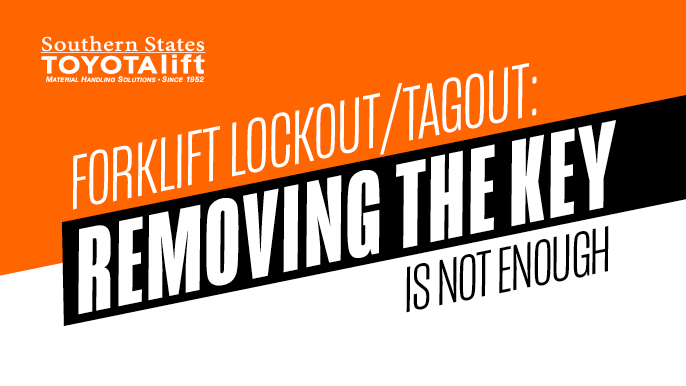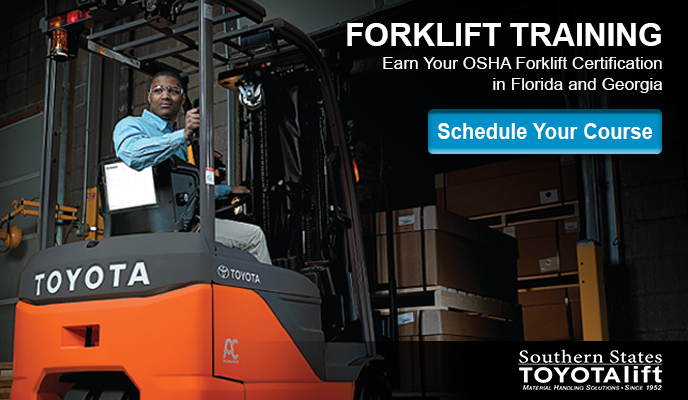Forklift Lockout/Tagout - Removing the Key Is Not Enough
by David Tullis, on May 28, 2021 4:46:00 PM
 When your forklift goes down, it can be a significant inconvenience. Many companies aren’t prepared to lock out their trucks at all. The result? A rushed attempt to lockout, leading to safety concerns and possible OSHA violations. Let’s take a look at proper lockout/tagout procedures below. Your associates will be safer, and your business won’t be fined.
When your forklift goes down, it can be a significant inconvenience. Many companies aren’t prepared to lock out their trucks at all. The result? A rushed attempt to lockout, leading to safety concerns and possible OSHA violations. Let’s take a look at proper lockout/tagout procedures below. Your associates will be safer, and your business won’t be fined.
What’s the OSHA Lockout/Tagout Standard All About?
OSHA’s standard protects workers from energy bursts or startups while repairing equipment. OSHA standards 1910.147 and 1910.33 go into detail about proper lockout procedure. In a nutshell, these procedures tell you exactly how to lock and tag a down truck.
Using a lockbox and a tag, you can pass OSHA inspections and avoid any issues. The lockbox isolates the forklift’s power source so no one can use the machinery. The red and white tag explains why the equipment is locked down.
Why Do You Need to Follow These Procedures?
The main reason is your workers’ safety. If there is no lockout/tagout procedure, someone may be unaware the machine is damaged. It can start up suddenly, severely injuring the operator or maintenance worker. It is also an OSHA requirement - and if you break it, you may pay a hefty fine.
Avoid Common - and Costly - Shortcuts
No companies look forward to locking down their crucial equipment. But, if you don’t handle it right, it can bite you. Some common shortcuts to avoid are:
- Removing the Key Is Not Enough. Many operators believe that simply removing the key is enough. It’s not - in both electric and LP forklifts. The problem is that the energy source is still not isolated. This can lead to severe injuries from energy bursts.
- Not Training Your Employees on Procedures. Clear communication is critical. Your team needs to know where to turn for lockout information. They also need to be aware of dangerous situations. Document your procedures.
- Failing to Regularly Re-Train: Without refreshers, your team may forget protocols. Make sure to conduct inspections and lockout/tagout training at regular intervals. You may need to make adjustments and analyze the process.
So, What Is the Correct Lockout/Tagout Procedure?
This procedure below adheres to the OSHA requirements. You can tailor these steps to fit your company’s safety mission.
- Alert all relevant team members when equipment goes down.
- Shut down the machine or vehicle according to procedure. Disconnect any energy sources.
- Use the lockout box and attach the tag. The tag should have contact information and reasons for the lockout.
- Discharge any residual energy from the energy source.
- Try to start the equipment to see if it is disabled.
- Qualified associate performs maintenance on the machine.
- Perform steps in reverse to return the forklift to operation.
Locking out a truck can be stressful, but doesn’t have to be. If you follow the above lockout/tagout procedures, you’ll do it right. You won’t stress when equipment stops. Not only will you protect your associates, but you will be compliant with OSHA.
Need more tips or info about lockout/tagout? We’ll come to you! With our free facility audits, we will check that you are OSHA-compliant and safe. We also have forklift safety experts you can contact online, by phone at (800) 226-2345, or in-person at one of our 9 locations.
Further Reading:
Top 8 Forklift Safety Products
Forklift Safety Checklist
Why Are Forklift Pre-Shift Inspections Important?









